Reservoir Properties of Lacustrine Deep-Water Gravity Flow Deposits in the Late Triassic–Early Jurassic Anyao Formation, Paleo-Ordos Basin, China
Abstract
1. Introduction
2. Geological Setting
3. Materials and Methods
4. Results and Analysis
4.1. Lithofacies and Environmental Interpretation
4.1.1. Facies Association DL: Deep Lacustrine
4.1.2. Facies Association SP: Slump
4.1.3. Facies Association SDF: Sandy Debris Flows
4.1.4. Facies Association TC: Turbidity Currents
4.2. Clastic Rock Component and Texture
4.3. Pore System
4.3.1. Thin-Section Porosity and Pore Types
4.3.2. Pore Throat Characteristics
4.3.3. Porosity and Permeability
4.4. Diagenesis Processes
5. Discussion
5.1. Controls on the Porosity of Two Gravity Flow Reservoirs
5.1.1. Rock Texture
5.1.2. Diagenesis
5.2. Controls on Permeability of Two Gravity Flow Reservoirs
5.2.1. Rock Texture
5.2.2. Pore Throat Radius
5.2.3. Sorting of Pore Throat Radius
6. Conclusions
- (1)
- Petrological and sedimentological data reveal two deep-water gravity flow deposits comprising sandy detrital flow (SDF) and turbidity current (TC) deposits. Both are fine-grained lithic sandstone reservoirs, with low porosity (secondary dissolution pore as dominant pore type) and ultra-low permeability. Four diagenetic types are identified (compaction, cementation, metasomatism, and dissolution), and the widespread presence of dissolution indicates that the Anyao Formation is in stage A of middle diagenesis.
- (2)
- Compared with the TC samples, the average values of SDF are higher in the content (87.9% vs. 84.8%) and particle size (0.091 mm vs. 0.008 mm) of framework grains, porosity (6.97% vs. 3.44%), pore throat radius (0.102 μm vs.0.025 μm), and permeability (0.025 vs. 0.005 mD), but are relatively poor in the sorting of framework grain size (σ values 0.68 vs. 0.62) and pore throat radius (SCPo, 2.16 vs. 1.30).
- (3)
- The porosity-affecting factors in petrology for SDF reservoirs include framework grain size, rigid grain content, feldspar grain content, and framework grain sorting in descending order. However, for TC reservoirs they are feldspar grain content, rigid grain content, and framework grain size. The dissolution of framework grains is the most important porosity-affecting factor in diagenesis for both SDF and TC reservoirs. The permeability-affecting factors for SDF reservoirs are feldspar grain content, rigid grain content, framework grain size, framework grain sorting, and the median and average pore throat radius in descending order. In contrast, for TC reservoirs only the pore throat radius is a permeability-affecting factor, and the maximum pore throat radius has the greatest influence.
- (4)
- The difference in the gravity flow subphases in deep water directly affects the physical properties of reservoirs. Strengthening the study of gravity flow sub-facies is an important direction of future gravity flow reservoir research, so as to accurately explore and develop high-quality deep-water gravity flow reservoirs. It also provides a new idea for the accurate exploration and development of high-quality deep-water gravity flow reservoirs around the world.
Supplementary Materials
Author Contributions
Funding
Data Availability Statement
Acknowledgments
Conflicts of Interest
References
- Wang, F.; Chen, R.; Yu, W.; Tian, J.; Liang, X.; Tan, X.; Gong, L. Characteristics of lacustrine deepwater fine-grained lithofacies and source-reservoir combination of tight oil in the triassic chang 7 member in Ordos Basin, China. J. Pet. Sci. Eng. 2021, 202, 108429. [Google Scholar] [CrossRef]
- Xian, B.; Wang, J.; Gong, C.; Yin, Y.; Chao, C.; Liu, J.; Zhang, G.; Yan, Q. Classification and sedimentary characteristics of lacustrine hyperpycnal channels: Triassic outcrops in the south Ordos Basin, central China. Sediment. Geol. 2018, 368, 68–82. [Google Scholar] [CrossRef]
- Niu, X.; Yang, T.; Cao, Y.; Li, S.; Zhou, X.; Xi, K.; Thomas, J. Characteristics and formation mechanisms of gravity-flow deposits in a lacustrine depression basin: Examples from the Late Triassic Chang 7 oil member of the Yanchang Formation, Ordos Basin, Central China. Mar. Pet. Geol. 2023, 148, 106048. [Google Scholar] [CrossRef]
- Yang, T.; Cao, Y.; Wang, Y.; Zhang, S. Types, sedimentary characteristics and genetic mechanisms of deep-water gravity flows: A case study of the middle submember in Member 3 of Shahejie Formation in Jiyang depression. Acta Pet. Sin. 2015, 36, 1048–1059. [Google Scholar]
- Pan, S.; Liu, H.; Zavala, C.; Liu, C.; Liang, S.; Zhang, Q.; Bai, Z. Sublacustrine hyperpycnal channel-fan system in a large depression basin: A case study of Nen 1 Member, Cretaceous Nenjiang Formation in the Songliao Basin, NE China. Pet. Explor. Dev. 2017, 44, 860–870. [Google Scholar] [CrossRef]
- Cao, Y.; Wang, Y.; Gluyas, J.G.; Liu, H.; Liu, H.; Song, M. Depositional model for lacustrine nearshore subaqueous fans in a rift basin: The Eocene Shahejie Formation, Dongying Sag, Bohai Bay Basin, China. Sedimentology 2018, 65, 2117–2148. [Google Scholar] [CrossRef]
- Shanmugam, G. New perspectives on deep-water sandstones: Implications. Pet. Explor. Dev. 2013, 40, 316–324. [Google Scholar] [CrossRef]
- Peng, J.; Hu, Z.; Feng, D.; Wang, Q. Sedimentology and sequence stratigraphy of lacustrine deep-water fine-grained sedimentary rocks: The Lower Jurassic Dongyuemiao Formation in the Sichuan Basin, Western China. Mar. Pet. Geol. 2022, 146, 105933. [Google Scholar] [CrossRef]
- Talling, P.J.; Wynn, R.B.; Masson, D.G.; Frenz, M.; Cronin, B.T.; Schiebel, R.; Akhmetzhanov, A.M.; Dallmeier-Tiessen, S.; Benetti, S.; Weaver, P.P.E.; et al. Onset of submarine debris flow deposition far from original giant landslide. Nature 2007, 450, 541–544. [Google Scholar] [CrossRef]
- Yang, W.; Wu, M.; Yang, H.; Shi, F.; Liang, T. Sedimentary characteristics and tectonic significance of gravity flow deposits of the Lower Jurassic Anyao Formation in Jiyuan Basin Henan Province. J. Palaeogeo. 2017, 19, 433–444. [Google Scholar]
- Yang, T.; Cao, Y.; Tian, J. Discussion on research of deep-water gravity flow deposition in lacustrine basin. Acta Sedimentol. Sin. 2021, 39, 88–111. [Google Scholar]
- Yang, T.; Cao, Y.; Tian, J.; Niu, X.; Li, S.; Zhou, X.; Jin, J.; Zhang, Y. Deposition of deep-water gravity-flow hybrid event beds in lacustrine basins and their sedimentological significance. Acta Geolo. Sin. 2021, 95, 3842–3857. [Google Scholar]
- Li, J.; Liu, Z.; Xie, X.; Fang, Y. New understanding of deep-water gravity flow deposition mechanism and its application in the discovery of G oilfield in North sea. J. Palaeogeo. 2021, 33, 23–31. [Google Scholar]
- Zhang, J.; Li, S.; Li, H.; Zhou, X.; Liu, J.; Guo, R.; Chen, J.; Li, S. Gravity flow deposits in the distal lacustrine basin of the 7th reservoir group of Yanchang Formation and deepwater oil and gas exploration in Ordos Basin: A case study of Chang 73 sublayer of Chengye horizontal well region. Acta Pet. Sin. 2021, 42, 570–587. [Google Scholar]
- Lowe, D.R. Sediment gravity flows: Their classification and some problems of application to natural flows and deposits. In Geology of Continental Slopes; SEPM Special Publication: Tulsa, OK, USA, 1979; Volume 27, pp. 75–82. [Google Scholar]
- Middleton, G.V.; Hampton, M.A. Sediment gravity flows: Mechanics of flow and deposition. In Turbidity and Deep Water Sedimentation; Short Course Lecture Notes; Middleton, G.V., Bouma, A.H., Eds.; SEPM, Pacific Section: Fullerton, CA, USA, 1973; pp. 1–38. [Google Scholar]
- Lai, J.; Wang, G.; Ran, Y.; Zhou, Z.; Cui, Y. Impact of diagenesis on the reservoir quality of tight oil sandstones: The case of Upper Triassic Yanchang Formation Chang 7 oil layers in Ordos Basin, China. J. Pet. Sci. Eng. 2016, 145, 54–65. [Google Scholar] [CrossRef]
- Lai, J.; Wang, G.; Wang, Z.; Chen, J.; Pang, X.; Wang, S.; Zhou, Z.; He, Z.; Qin, Z.; Fan, X. A review on pore structure characterization in tight sandstones. Earth-Sci. Rev. 2018, 177, 436–457. [Google Scholar] [CrossRef]
- Ma, B.; Chen, S.; Yan, W.; Lin, C.; Zhang, H.; Sun, Z.; Zheng, J.; Wang, Y.; Wu, S.; Wang, J. Pore structure evaluation of low permeability clastic reservoirs based on sedimentation diagenesis: A case study of the Chang 8 reservoirs in the Zhenbei region, Ordos Basin. J. Pet. Sci. Eng. 2021, 196, 107841. [Google Scholar] [CrossRef]
- Cao, J.; Wang, Q.; Fan, L.; Yuan, X.; Wei, F. Deep water tight sandstone reservoir characteristics and diagenetic facies analysis: A case study of Chang 7 oil-bearing formation in Xifeng area, Ordos Basin, NW China. J. Northwest Univ. (Nat. Sci. Ed.) 2021, 51, 80–94. [Google Scholar]
- Zou, C.; Yang, Z.; Dong, D.; Zhao Qun Chen, Z.; Feng, Y.; Li, J.; Wang, X. Formation, distribution and prospect of unconventional hydrocarbons in source rock strata in China. Earth Sci. 2022, 47, 1517–1533. [Google Scholar]
- Jia, C.; Zheng, M.; Zhang, Y. Unconventional hydrocarbon resources in China and the prospect of exploration and development. Pet. Explor. Dev. 2012, 39, 129–136. [Google Scholar] [CrossRef]
- Zou, C.; Wang, L.; Li, Y.; Tao, S.; Hou, L. Deep-lacustrine transformation of sandy debrites into turbidites, Upper Triassic, Central China. Sediment. Geol. 2012, 265–266, 143–155. [Google Scholar] [CrossRef]
- He, Z. Evolution and Oil and Gas in the Ordos Basin; Petroleum Industry Press: Beijing, China, 2003. [Google Scholar]
- Gu, J. Development Review and Current Application of Petroleum Sedimentology. Acta Sedimentol. Sin. 2003, 21, 137–141. [Google Scholar]
- Li, X.; Chen, Q.; Liu, H.; Wan, Y.; Mu, J.; Liao, J.; Wei, L. Three types of sediment gravity flows and their petroliferous features of Yanchang Formation in Ordos Basin. Lithol. Reserv. 2010, 22, 16–21. [Google Scholar]
- Liao, J.; Zhu, X.; Deng, X.; Sun, B.; Hui, X. Sedimentary characteristics and model of gravity flow in Triassic Yanchang Formation of Longdong area in Ordos Basin. Earth Sci. Front. 2013, 20, 29–39. [Google Scholar]
- Liu, F.; Zhu, X.; Li, Y.; Xu, L.; Niu, X.; Zhu, S.; Liang, X.; Xue, M.; He, J. Sedimentary characteristics and facies model of gravity flow deposits of Late Triassic Yanchang Formation in southwestern Ordos Basin, NW China. Pet. Explor. Dev. 2015, 42, 577–588. [Google Scholar] [CrossRef]
- Zhao, J.; Liu, C.; Liang, J.; Wang, X.; Yu, L.; Huang, L.; Liu, Y. Restoration of the original sedimentary boundary of the Middle Jurassic Zhiluo Formation -Anding Formation in the Ordos Basin. Acta Geol. Sin. 2010, 84, 553–569. [Google Scholar]
- Liu, S.; Su, S.; Zhang, G. Early Mesozoic basin development in North China: Indications of cratonic deformation. J. Asian Earth Sci. 2013, 62, 221–236. [Google Scholar] [CrossRef]
- Yang, W.; Wang, M.; Du, Y. The depositional characteristics from Mesozoic Jiyuan Basin with its response to the uplift of Qinling Orogen and Taihang Mountains. Geol. Rev. 2014, 60, 260–274. [Google Scholar]
- Hu, B. The Late Triassic and Middle Jurassic continental strata of Jiyuan Basin in Henan Province. J. Stratigr. 1991, 15, 48–52. [Google Scholar]
- Wu, X. Trace fossils and their environmental significance in non-marine turbidite deposits from Jiyuan-Yima Basin, western Henan. Acta Sediment. Sin. 1985, 3, 23–31. [Google Scholar]
- Hu, B.; Zhang, L.; Qi, Y.; Guo, W. Sedimentary structures and environments of Lower Jurassic Anyao Formation, Jiyuan, Central China. J. Jiaozuo Inst. Tec. 2004, 23, 18–22. [Google Scholar]
- Hu, B.; Lu, X.; Song, H. Lower Triassic ichnofossils and sedimentary environments in the Dengfeng Area, Western Henan Province. J. Stratigr. 2015, 39, 454–465. [Google Scholar]
- Zhang, S. Deep-water sedimentary model and environmental evolution of the Anyao Formation in the Jiyuan Basin. Ph.D. Thesis, China University of Mining Technology, Beijing, China, 2020. [Google Scholar]
- Lu, J.; Zhang, P.; Dal Corso, J.; Yang, M.; Wignall, P.B.; Greene, S.E.; Shao, L.; Lyu, D.; Hilton, J. Volcanically driven lacustrine ecosystem changes during the Carnian Pluvial Episode (Late Triassic). Proc. Natl. Acad. Sci. USA 2021, 118, e2109895118. [Google Scholar] [CrossRef]
- Yang, W.; Yang, J.; Wang, X.; Du, Y. Geochronology from middle Triassic to middle Jurassic Detrital Zircons in Jiyuan Basin and its implications for the Qinling Orogen. Earth. Sci. 2012, 37, 489–500. [Google Scholar]
- Zhang, P.; Lu, J.; Yang, M.; Bond, D.P.G.; Greene, S.E.; Liu, L.; Zhang, Y.; Wang, Y.; Wang, Z.; Li, S.; et al. Volcanically-induced environmental and floral changes across the Triassic-Jurassic (T-J) transition. Front. Ecol. Evol. 2022, 10, 853404. [Google Scholar] [CrossRef]
- Chen, A.; Chen, H.; Hou, M. The Middle-Late Triassic event sediments in Ordos Basin: Indicators for episode I of the Indosinian Movement. Acta Geolo. Sin. 2011, 85, 1681–1690. [Google Scholar]
- Sun, Y.D.; Richoz, S.; Krystyn, L.; Zhang, Z.; Joachimski, M.M. Perturbations in the carbon cycle during the Carnian Humid Episode: Carbonate carbon isotope records from southwestern China and northern Oman. J. Geol. Soc. 2019, 176, 167–177. [Google Scholar] [CrossRef]
- Miall, A.D. Lithophacies types and vertical profile models in braided rivers: A summary. Fluv. Sedimentol. 1977, 5, 597–604. [Google Scholar]
- Walther, J. Einleitung in die Geologie als historische Wissen schaft. In Lithogenesis der Gegenwart; Fischer, G., Ed.; Forgotten Books: Jena, Germany, 1894; pp. 535–1055. [Google Scholar]
- GB/T 17361-2013; Microbeam Analysis—Identification of Authigenic Clay Mineral in Sedimentary Rock Menthod by Scanning Electron Microscope and Energy Dispersive Spectrometer. Standardization Administration of the People’s Republic of China: Beijing, China, 2013.
- Folk, R.L. Petrology of Sedimentary Rocks; Hemphill Publishing Company: Austin, TX, USA, 1980. [Google Scholar]
- Nichols, G. Sedimentology and Stratigraphy, 2nd ed.; Wiley-Blackwell: Chichester, UK, 2009; pp. 1–419. [Google Scholar]
- Buatois, L.A.; Mangano, M.G.; Wu, X.T.; Zhang, G.C. Trace fossils from Jurassic lacustrine turbidites of the Anyao Formation (central China) and their environmental and evolutionary significanc. Ichnos 1996, 5, 287–301. [Google Scholar] [CrossRef]
- Hu, B.; Jiang, Z.; Qi, Y.; Zhang, G. Trace fossils of deeper lacustrine deposits in the Paleogene Shahejie Formation of Jiyang depression, Shandong province, Eastern, China. Acta Palaeontol. Sin. 2006, 45, 83–94. [Google Scholar]
- Lv, Q.; Luo, S.; Fu, J.H.; Xiang, J.; Niu, X.; Gong, C.; Xu, L.M.; Feng, S.B.; Li, S.X. Outcrop-Based Analysis of a Deep-Water Gravity Flow Sediments in Lake:A Case Study from the Chang 7 of Yaoqu Section, Ordos Basin. Acta Geol. Sin. 2017, 91, 617–628. [Google Scholar]
- Shanmugam, G. 50 years of the turbidite paradigm (1950s–1990s): Deep-water processes and facies models—A critical perspective. Mar. Pet. Geol. 2000, 17, 285–342. [Google Scholar] [CrossRef]
- Stow, D.A.V. Sedimentary Rocks in the Field: A Colour Guide; Manson Publishing Ltd.: London, UK, 2005; p. 320. [Google Scholar]
- Liu, B.; Shao, L.Y.; Wang, W.; Huang, X.; Liu, W.; Zhang, S.; Zhang, H.; Lu, J. Sedimentary characteristics and deposition model of deep-water deposits dominated by gravity flow: A case study from the Lower Triassic in the Gonghe Basin. Acta Geol. Sin. 2020, 94, 1106–1127. [Google Scholar]
- Visher, G.S. Grain size distributions and depositional processes. J. Sediment. Res. 1969, 39, 1074–1106. [Google Scholar] [CrossRef]
- Shanmugam, G.; Lehtonen, L.R.; Straume, T.; Syvertsen, S.E.; Hodgkinson, R.J.; Skibeli, M. Slump and Debris-Flow Dominated Upper Slope Facies in the Cretaceous of the Norwegian and Northern North Seas (61-67øN): Implications for Sand Distribution. AAPG Bull. 1994, 78, 910–937. [Google Scholar]
- Fu, Y.; Li, Z.; Wan, P.; Que, Y.; Wang, Z.; Ji, Y.; Huang, L.; Luo, J.; Bao, Z. Sedimentary characteristics and controlling factors of slump gravity flow indelta front: A case study of Qing 1 member in Da’an area, Songliao Basin. Lithol. Reserv. 2021, 33, 198–208. [Google Scholar]
- Shanmugam, G. The Bouma Sequence and the turbidite mind set. Earth-Sci. Rev. 1997, 42, 201–229. [Google Scholar] [CrossRef]
- Shanmugam, G. Deep-Water Processes and Facies Models: Implications for Sandstone Petroleum Reservoirs: Handbook of Petroleum Exploration and Production 5; Elsevier: Amsterdam, The Netherlands, 2006; p. 476. [Google Scholar]
- Allen, J.R.L. Principles of Physical Sedimentology; George Allen & Unwin: London, UK, 1985; p. 272. [Google Scholar]
- Xia, J.; Liu, X.; Wang, Z.; Wen, W.; Tang, X. Sedimentary characteristics of sandy debris flow in the 3rd Member of Dongying Formation and the 1st Member of Shahejie Formation of the western Nanpu sag, Bohai Bay Basin and its significance in hydrocarbon exploration. Acta Pet. Sin. 2017, 38, 399–413. [Google Scholar]
- Li, Z.; Xu, Y.; Deng, J.; Li, Z.; Zhang, J.; Li, Y. Microscale sedimentary characteristics and distinguishing methods for deep-water sandy debris flow and turbidity flow in continental lakes: A case study of seventh member of Yanchang Formation, Ordos Basin. Pet. Geol. Exp. 2021, 43, 415–423. [Google Scholar]
- Cao, Y.; Jin, J.; Liu, H.; Yang, T.; Liu, K.; Wang, Y.; Wang, J.; Liang, C. Deep-water gravity flow deposits in a lacustrine rift basin and their oil and gas geological significance in eastern China. Pet. Explor. Dev. 2021, 48, 247–257. [Google Scholar] [CrossRef]
- Hiscott, R.N.; Middleton, G.V. Depositional Mechanics of Thick-Bedded Sandstones at the Base of a Submarine Slope, Tourelle Formation (Lower Ordovician), Quebec, Canada. Geol. Cont. Slopes 1979, 27, 307–326. [Google Scholar]
- Dott, R.H. Dynamics of Subaqueous Gravity Depositional Processes. AAPG Bull. 1963, 47, 104–128. [Google Scholar] [CrossRef]
- Crowell, J.C.; Hope, A.R.; Kahele, J.; Ovenshine, A.; Sams, R. Deep-Water Sedimentary Structures, Pliocene Pico Formation, Santa Paula Creek, Ventura Basin, California. AAPG Bull. 1964, 48, 522–523. [Google Scholar]
- Bouma, A.H. Sedimentology of Some Flysch Deposits: A Graphic Approach to Facies Interpretation; Elsevier: Amsterdam, The Netherlands, 1962; p. 168. [Google Scholar]
- Shanmugam, G. Ten turbidite myths. Earth-Sci. Rev. 2002, 58, 311–341. [Google Scholar] [CrossRef]
- Shanmugam, G. Deep-marine tidal bottom currents and their reworked sands in modern and ancient submarine canyons. Mar. Pet. Geol. 2003, 20, 471–491. [Google Scholar] [CrossRef]
- Li, X.; Liu, H.; Wan, Y.; Wei, L.; Liao, J.; Ma, Y. First discovery of the sandy debris flow from the Triassic Yanchang Formation, Ordos Basin. Lithol. Reserv. 2009, 21, 19–21. [Google Scholar]
- Yang, R.; Fan, A.; Han, Z.; van Loon, A.J.T. Lithofacies and origin of the Late Triassic muddy gravity-flow deposits in the Ordos Basin, central China. Mar. Pet. Geol. 2017, 85, 194–219. [Google Scholar] [CrossRef]
- Wang, Q.; Cao, J. Analysis and Evaluation of Main Controlling Factors of Chang8. Sino-Glob. Energy 2019, 24, 24–31. [Google Scholar]
- Lai, J.; Wang, G.; Chen, J.; Wang, S.; Zhou, Z.; Fan, X. Origin and distribution of carbonate cement in tight dandstones: The Upper Triassic Yanchang Formation Chang 8 Oil Layer in West Ordos Basin, China. Geofluids 2017, 2017, 8681753. [Google Scholar] [CrossRef]
- Kassab, M.A.; Hashish, M.F.A.; Nabawy, B.S.; Elnaggar, O.M. Effect of kaolinite as a key factor controlling the petrophysical properties of the Nubia sandstone in central Eastern desert. Egypt. J. Afr. Earth Sci. 2017, 125, 103–117. [Google Scholar] [CrossRef]
- Bjørlykke, K. Relationships between depositional environments, burial history and rock properties. Some principal aspects of diagenetic process in sedimentary basins. Sediment. Geol. 2014, 301, 1–14. [Google Scholar] [CrossRef]
- Bloch Salman Lander, R.H.; Bonnell, L. Anomalously high porosity and permeability in deeply buried sandstone reservoirs: Origin and predictability. AAPG Bull. 2002, 86, 301–328. [Google Scholar] [CrossRef]
- Reed, J.S.; Eriksson, K.A.; Kowalewski, M. Climatic, depositional and burial controls on diagenesis of Appalachian Carboniferous sandstones: Qualitative and quantitative methods. Sediment. Geol. 2005, 176, 225–246. [Google Scholar] [CrossRef]
- Zhang, J.; Qin, L.I.; Zhang, Z. Depositional facies, diagenesis and their impact on the reservoir quality of Silurian sandstones from Tazhong area in central Tarim Basin, western China. J. Asian Earth Sci. 2008, 33, 42–60. [Google Scholar] [CrossRef]
- Lai, J.; Wang, G.; Chai, Y.; Ran, Y.; Zhang, X. Depositional and diagenetic controls on reservoir pore structure of tight gas sandstones reservoirs: Evidence from Lower Cretaceous Bashijiqike Formation in Kelasu Thrust belts, Kuqa depression in Tarim Basin of West China. Resour. Geol. 2015, 65, 55–75. [Google Scholar] [CrossRef]
- Kordi, M.; Turnerc, B.; Salem, A.M.K. Linking diagenesis to sequence stratigraphy in fluvial and shallow marine sandstones: Evidence from the Cambrian–Ordovician lower sandstone unit in southwestern Sinai. Egypt. Mar. Pet. Geol. 2011, 28, 1554–1571. [Google Scholar] [CrossRef]
- Higgs, K.E.; Zwingmann, H.; Reyes, A.G.; Funnell, R.H. Diagenesis, porosity evolution, and petroleum emplacement in tight gas reservoirs, Taranaki basin, New Zealand. J. Sediment. Res. 2007, 77, 1003–1025. [Google Scholar] [CrossRef]
- Taylor, T.R.; Giles, M.R.; Hathon, L.A.; Diggs, T.N.; Braunsdorf, N.R.; Birbiglia, G.V.; Kittridge, M.G.; Macaulay, C.I.; Espejo, I.S. Sandstone diagenesis and reservoir quality prediction: Models, myths, and reality. AAPG Bull. 2010, 94, 1093–1132. [Google Scholar] [CrossRef]
- Zheng, J.; Pang, M. Diagenesis of Clastic Reservoir Rock; China University of Geosciences Press: Wuhan, China, 1989. [Google Scholar]
- Mørk, M.B.E. Diagenesis and quartz cement distribution of low-permeability Upper Triassic–Middle Jurassic reservoir sandstones, Longyearbyen CO2 lab well site in Svalbard, Norway. AAPG Bull. 2012, 97, 577–596. [Google Scholar] [CrossRef]
- Beard, D.C.; Weyl, P.K. Influence of texture on porosity and permeability of unconsolidated sand. AAPG Bull. 1973, 57, 349–369. [Google Scholar] [CrossRef]
- Morad, S.; Al-Ramadan, K.; Ketzer, J.M.; DeRos, L.F. The impact of diagenesis on the heterogeneity of sandstone reservoirs: A review of the role of depositional facies and sequence stratigraphy. AAPG Bull. 2010, 94, 1267–1309. [Google Scholar] [CrossRef]
- Nguyen, N.T.T.; Jones, S.J.; Goulty, N.R.; Middleton, A.J.; Grant, N.; Ferguson, A.; Bowen, L. The role of fluid pressure and diagenetic cements for porosity preservation in Triassic fluvial reservoirs of the Central Graben, North Sea. AAPG Bull. 2013, 97, 1273–1302. [Google Scholar] [CrossRef]
- Ajdukiewicz, J.M.; Lander, R.H. Sandstone reservoir quality prediction: The state of the art. AAPG Bull. 2010, 94, 1083–1091. [Google Scholar] [CrossRef]
- Mckinley, J.M.; Atkinson, P.M.; Lloyd, C.D.; Ruffell, A.H.; Worden, R.H. How porosity and permeability vary spatially with grain size, sorting, cement volume, and mineral dissolution in fluvial Triassic sandstones: The value of geostatistics and local regression. J. Sediment. Res. 2011, 81, 844–858. [Google Scholar] [CrossRef]
- Lai, J.; Wang, G.; Fan, Z.; Chen, J.; Wang, S.; Zhou, Z.; Fan, X. Insight into the pore structure of tight sandstones using NMR and HPMI measurements. Energy Fuels 2016, 30, 10200–10214. [Google Scholar] [CrossRef]
- Li, P.; Zheng, M.; Bi, H.; Wu, S.; Wang, X. Pore throat structure and fractal characteristics of tight oil sandstone: A case study in the Ordos basin, China. J. Pet. Sci. Eng. 2017, 149, 665–674. [Google Scholar] [CrossRef]
- Rezaee, R.; Saeedi, A.; Clennell, B. Tight gas sands permeability estimation from mercury injection capillary pressure and nuclear magnetic resonance data. J. Pet. Sci. Eng. 2012, 88–89, 92–99. [Google Scholar] [CrossRef]
- Schmitt, M.; Fernandes, C.P.; Wolf, F.G.; Neto, J.A.B.C.; Rahner, C.P. Characterization of Brazilian tight gas sandstones relating permeability and ang-strom-to micron-scale pore structures. J. Nat. Gas Sci. Eng. 2015, 27, 785–807. [Google Scholar] [CrossRef]
- Tian, X.; Cheng, L.; Cao, R.; Wang, Y.; Zhao, W.; Yan, Y.; Liu, H.; Mao, W.; Zhang, M.; Guo, Q. A new approach to calculate permeability stress sensitivity in tight sandstone oil reservoirs considering micro-pore-throat structure. J. Pet. Sci. Eng. 2015, 133, 576–588. [Google Scholar] [CrossRef]
- Xi, K.; Cao, Y.; Haile, B.G.; Zhu, R.; Jahren, J.; Bjørlykke, K.; Zhang, X.; Hellevang, H. How does the pore-throat size control the reservoir quality and oiliness of tight sandstones? The case of the Lower Cretaceous Quantou Formation in the southern Songliao Basin, China. Mar. Pet. Geol. 2016, 76, 1–15. [Google Scholar] [CrossRef]
- Dutton, S.P.; Loucks, R.D. Diagenetic controls on evolution of porosity and permeability in lower Tertiary Wilcox sandstones from shallow to ultradeep (200–6700 m) burial, Gulf of Mexico Basin, U.S.A. Mar. Pet. Geol. 2010, 27, 69–81. [Google Scholar] [CrossRef]
- Lai, J.; Wang, G.; Chai, Y.; Wu, D.; Yao, Y.; Zhang, Y.; Zhang, X.; Wang, D.; Li, M. Mechanism analysis and quantitative assessment of pore structure for tight sandstone reservoirs: An example from Chang 8 oil layer in the Jiyuan area of Ordos Basin. Acta Geol. Sin. 2014, 88, 2119–2130. [Google Scholar]
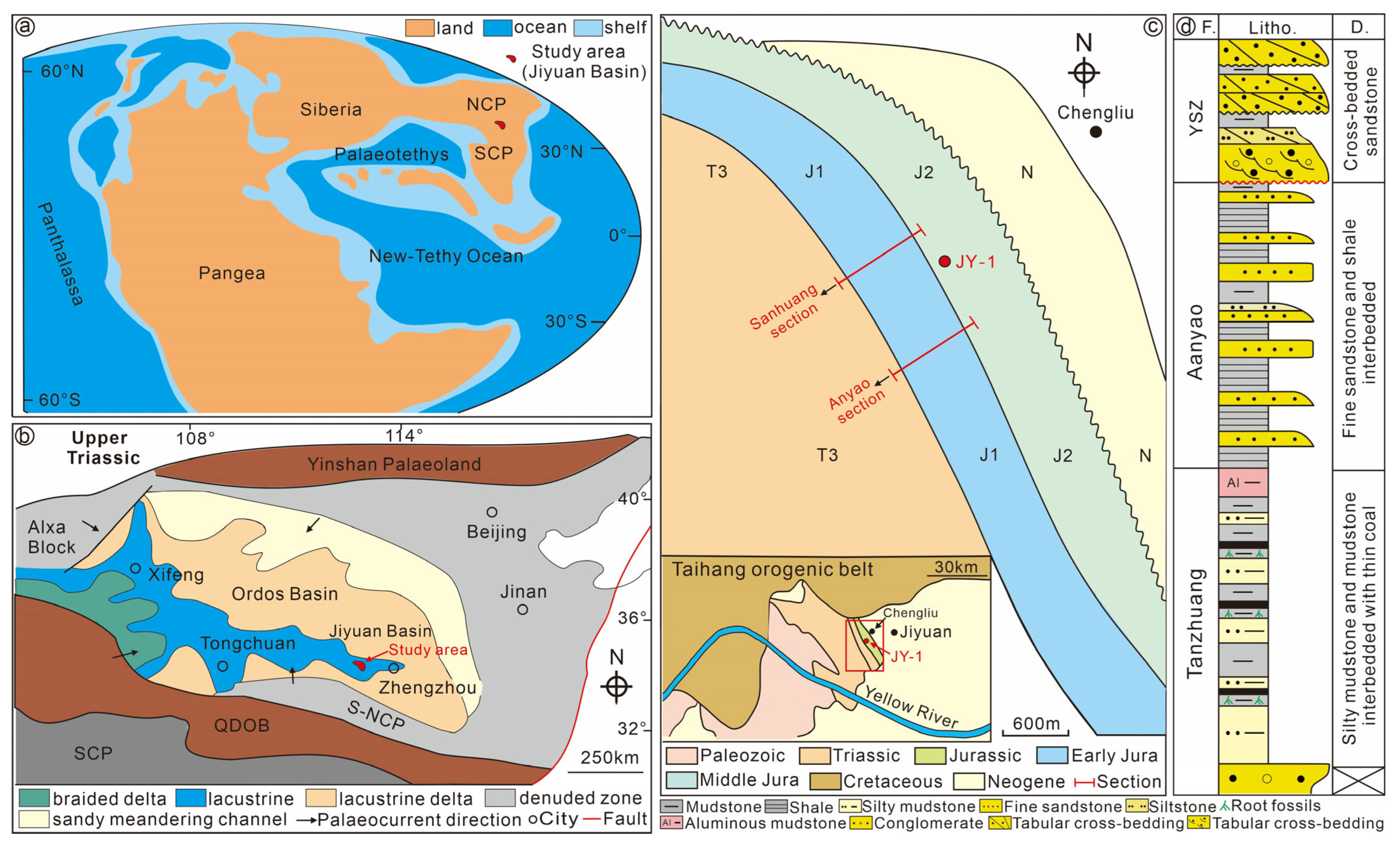
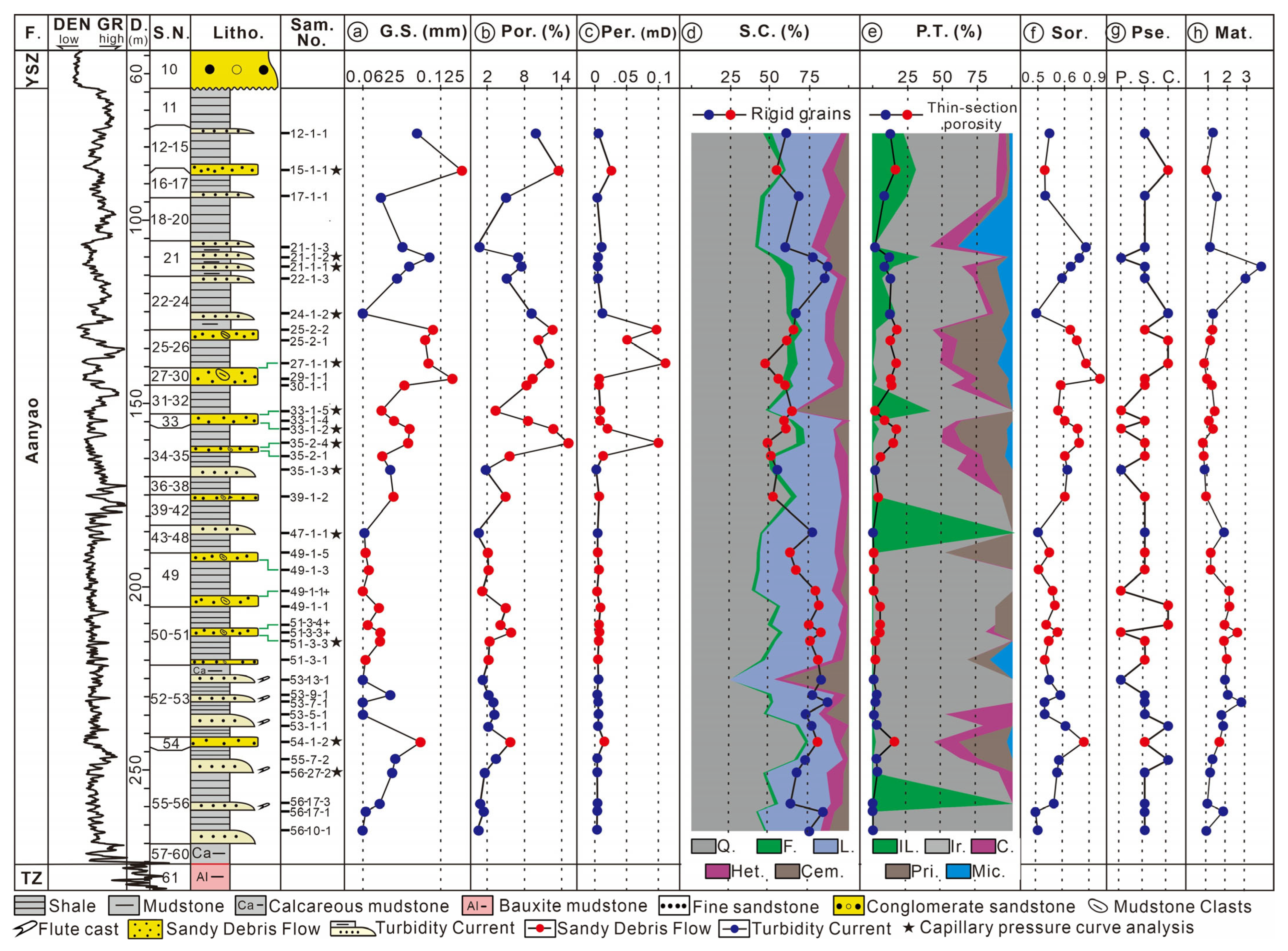
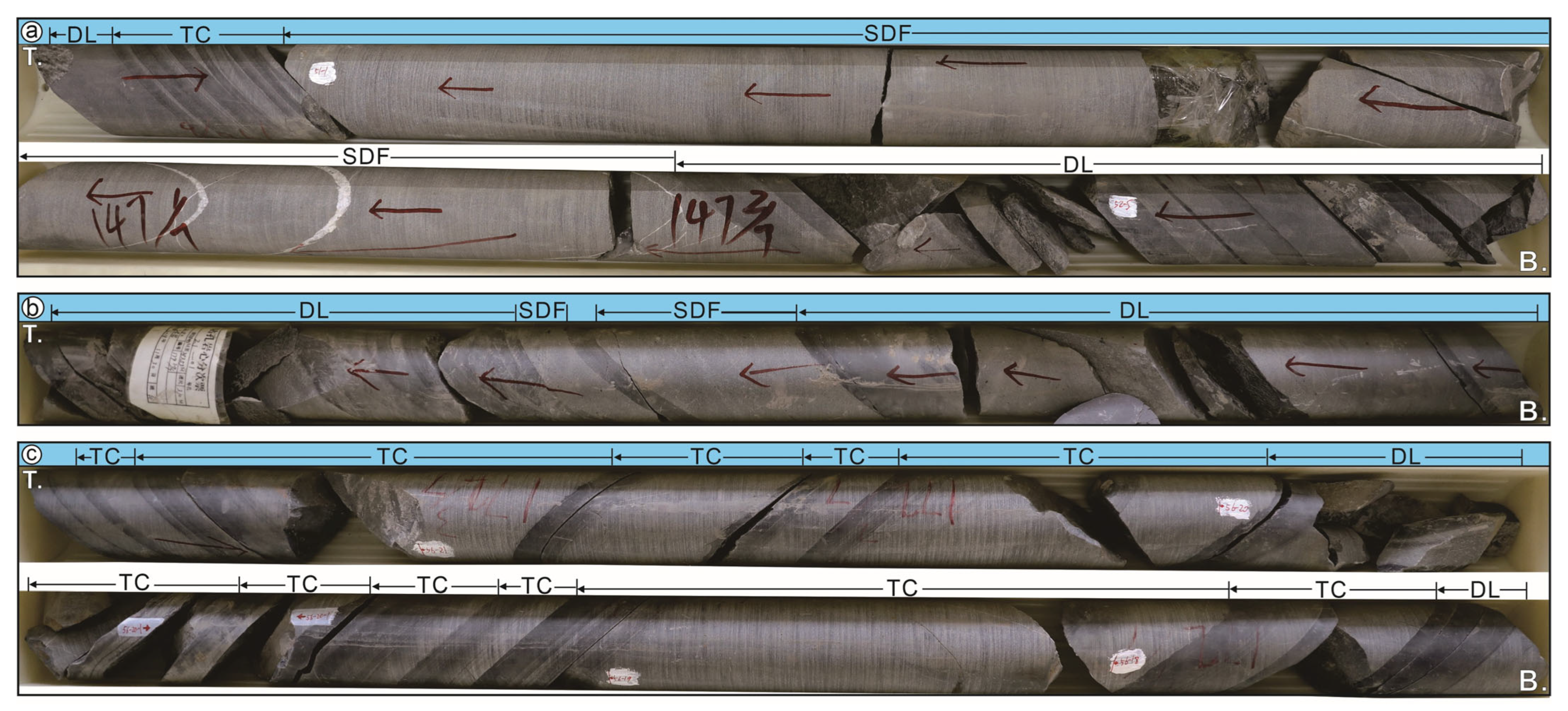
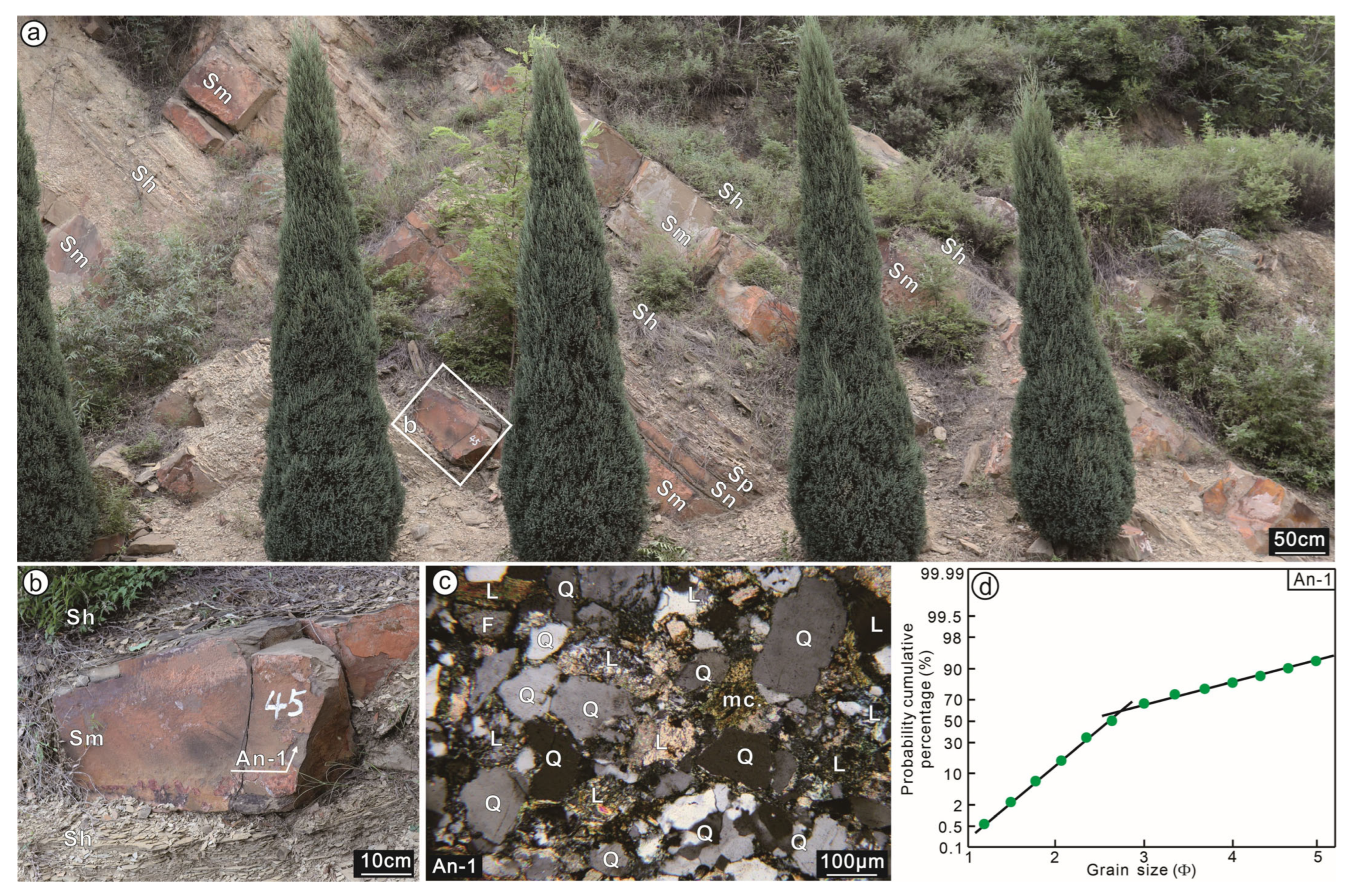
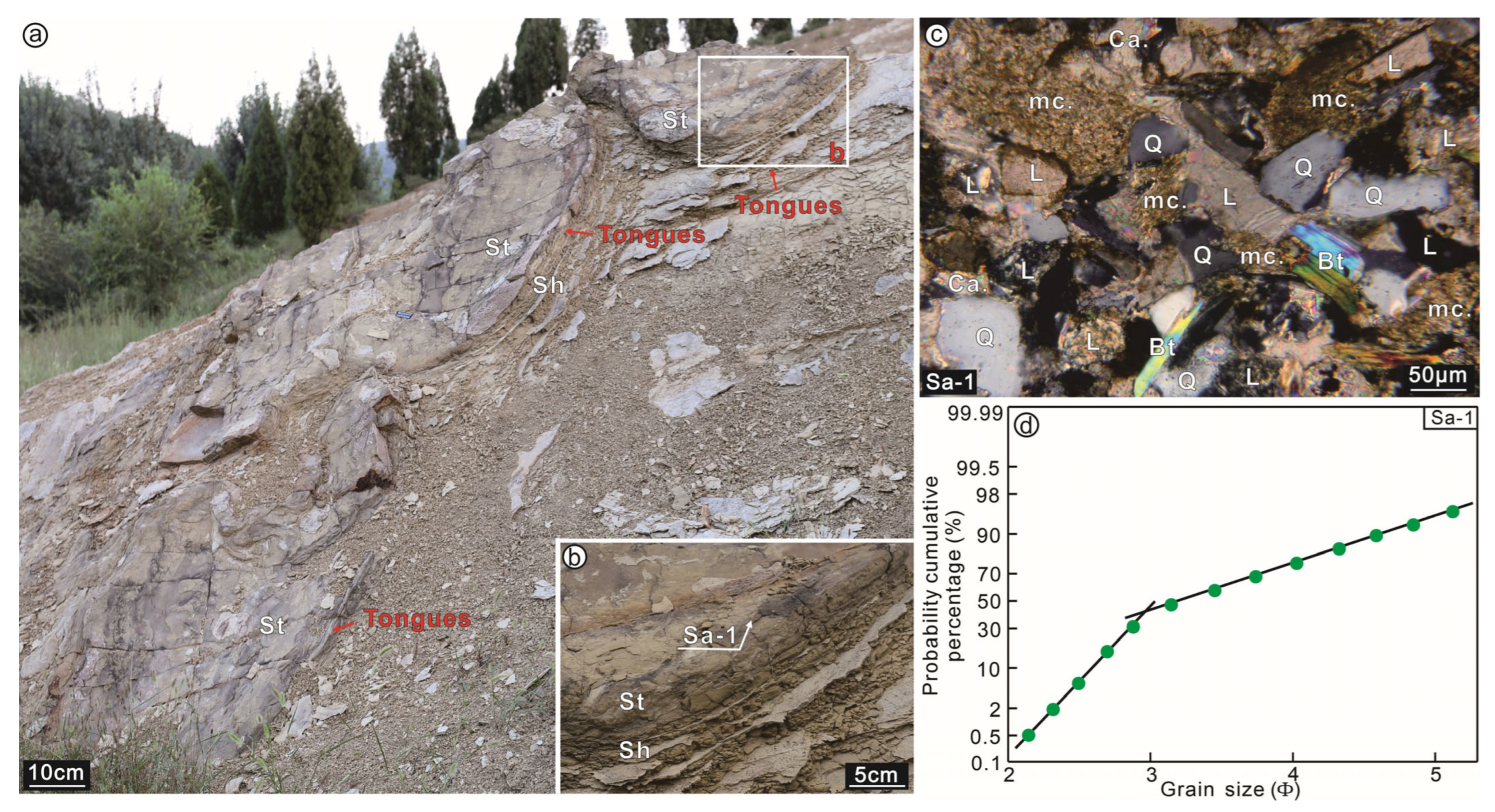
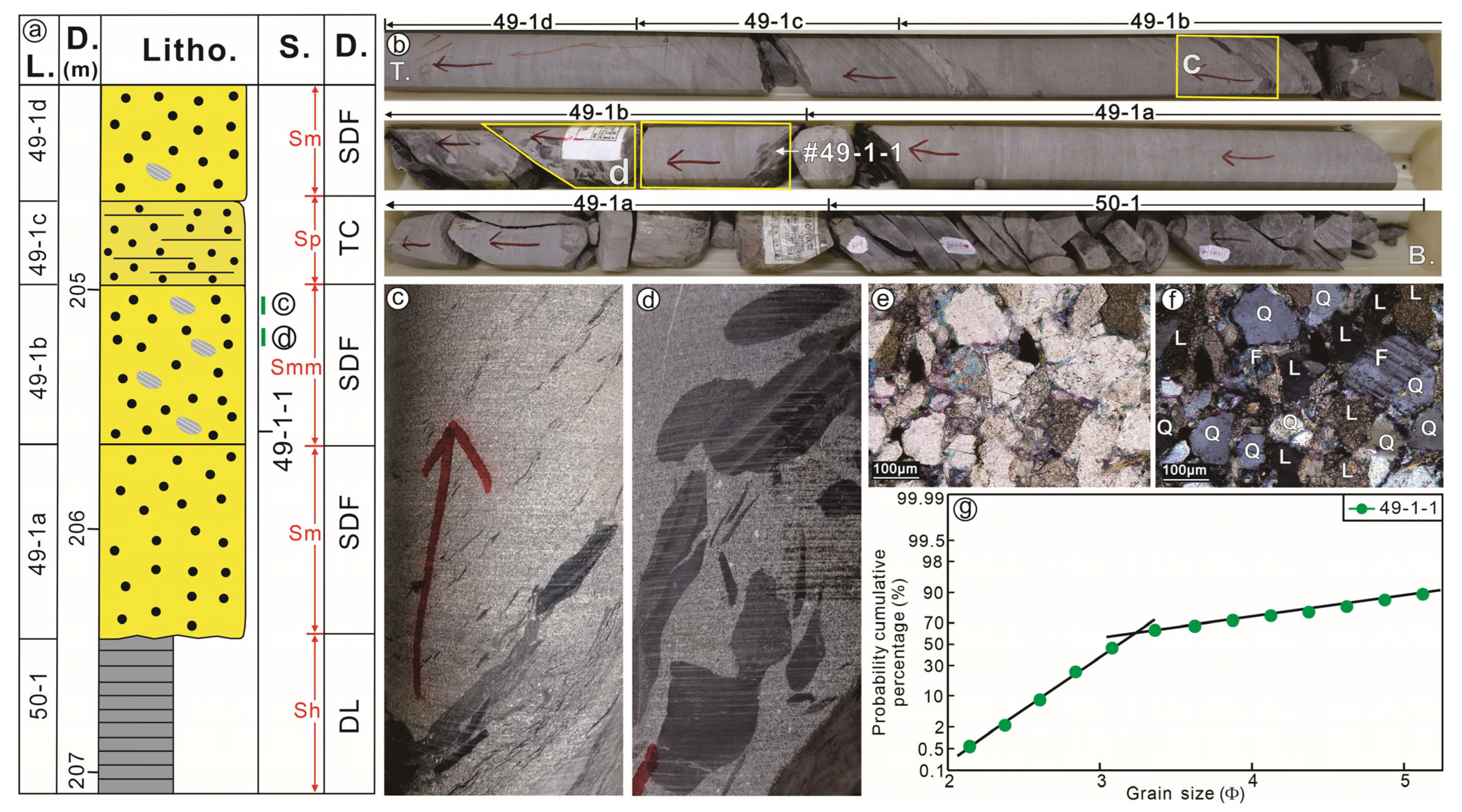
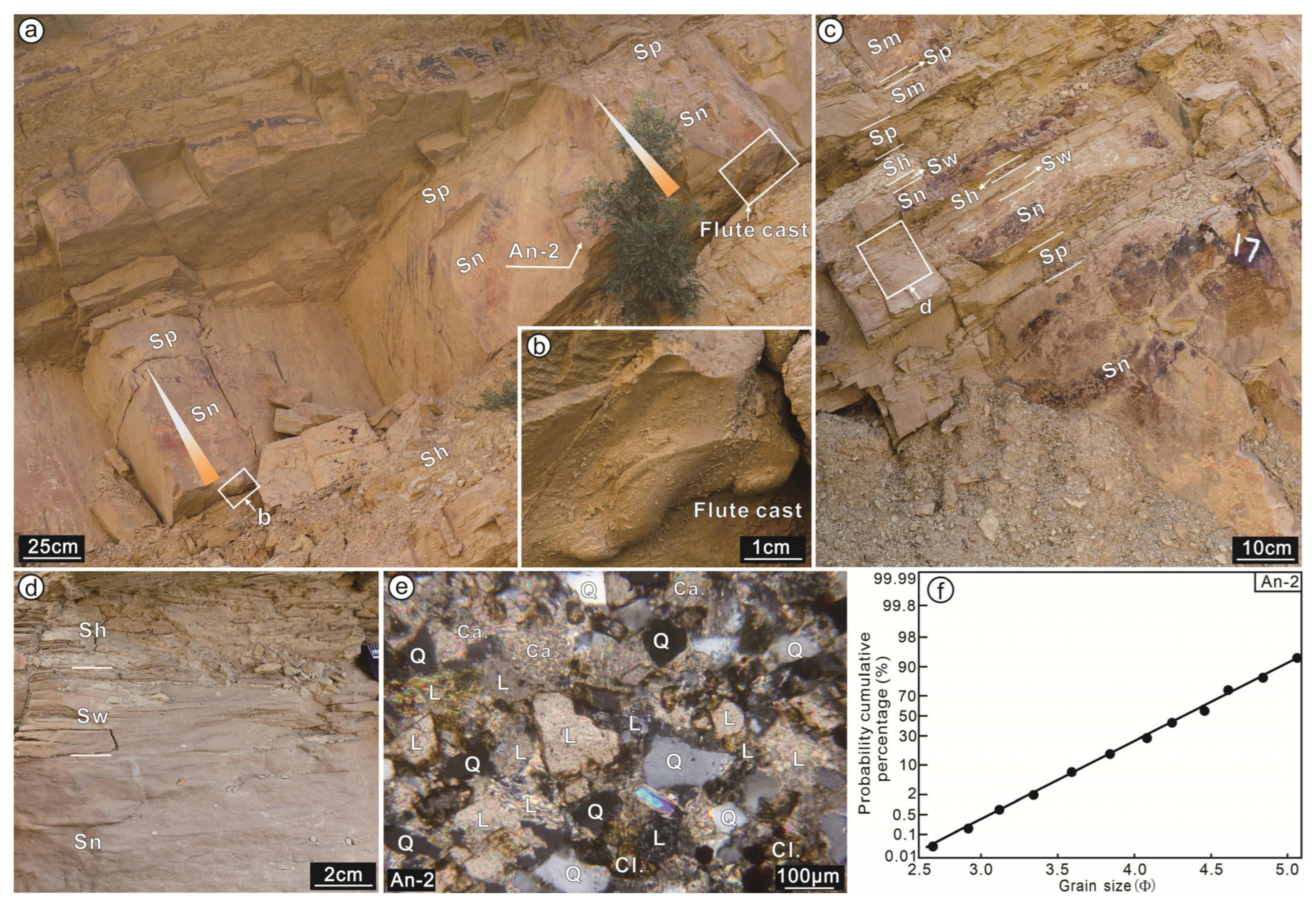

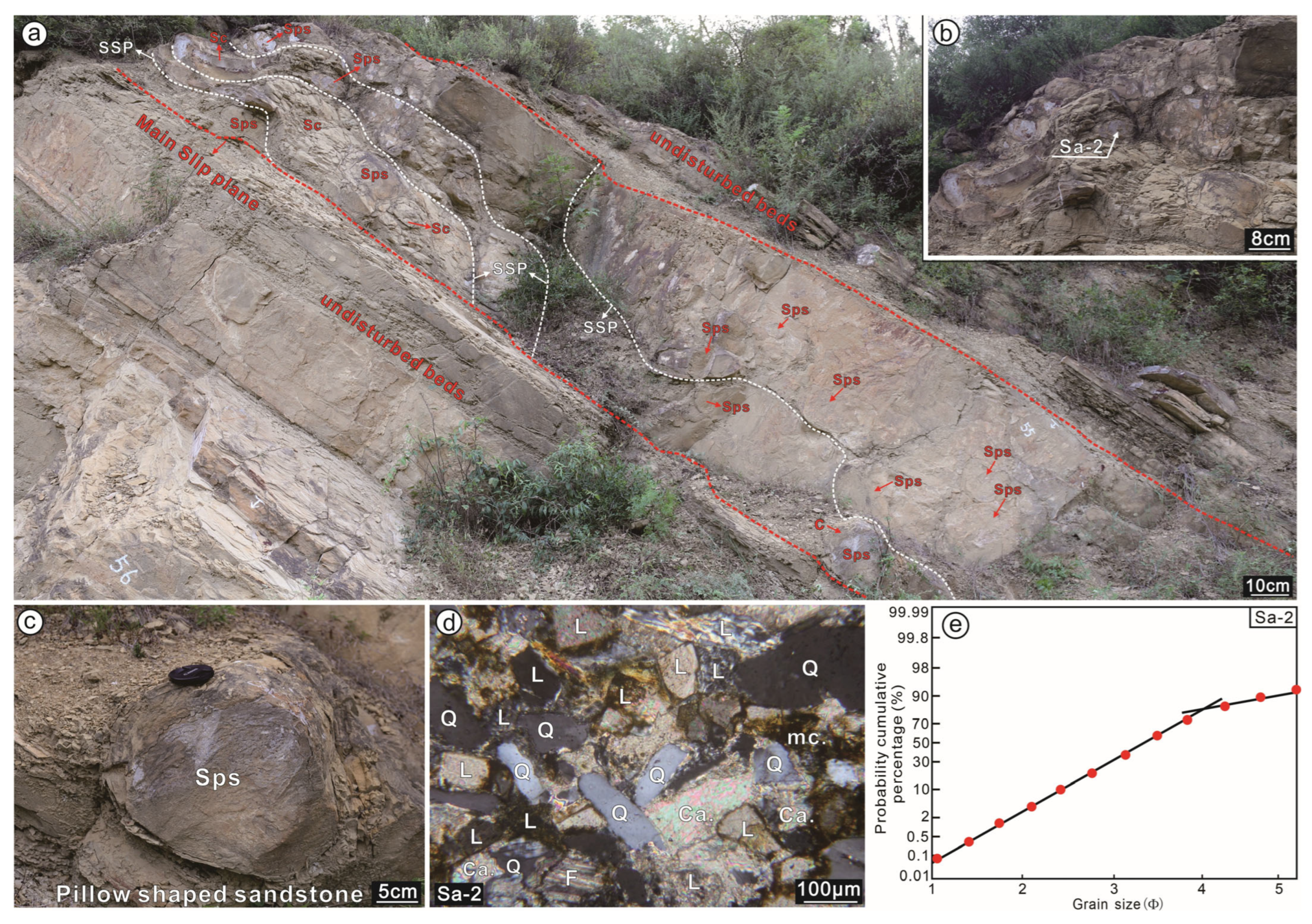
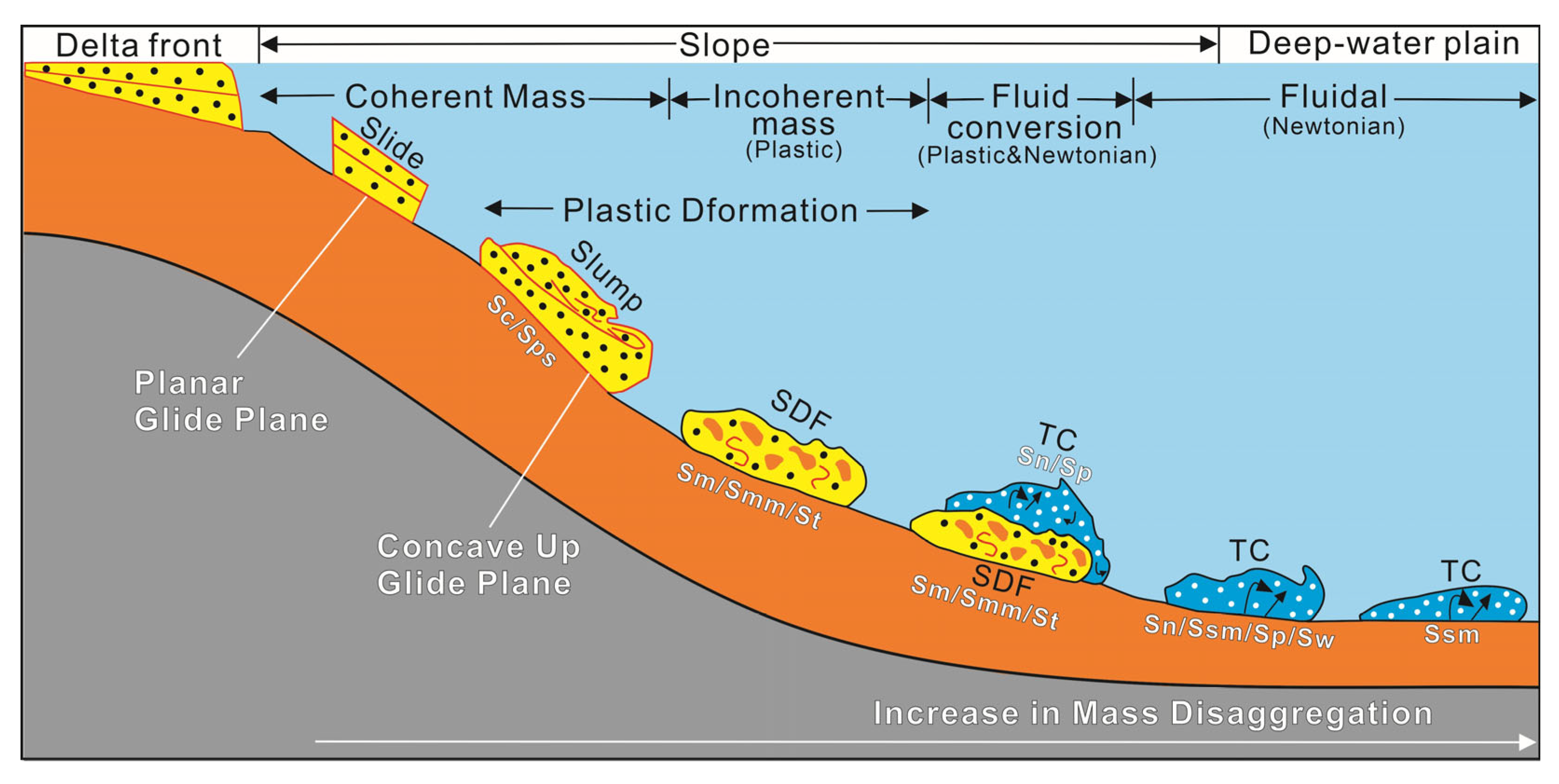


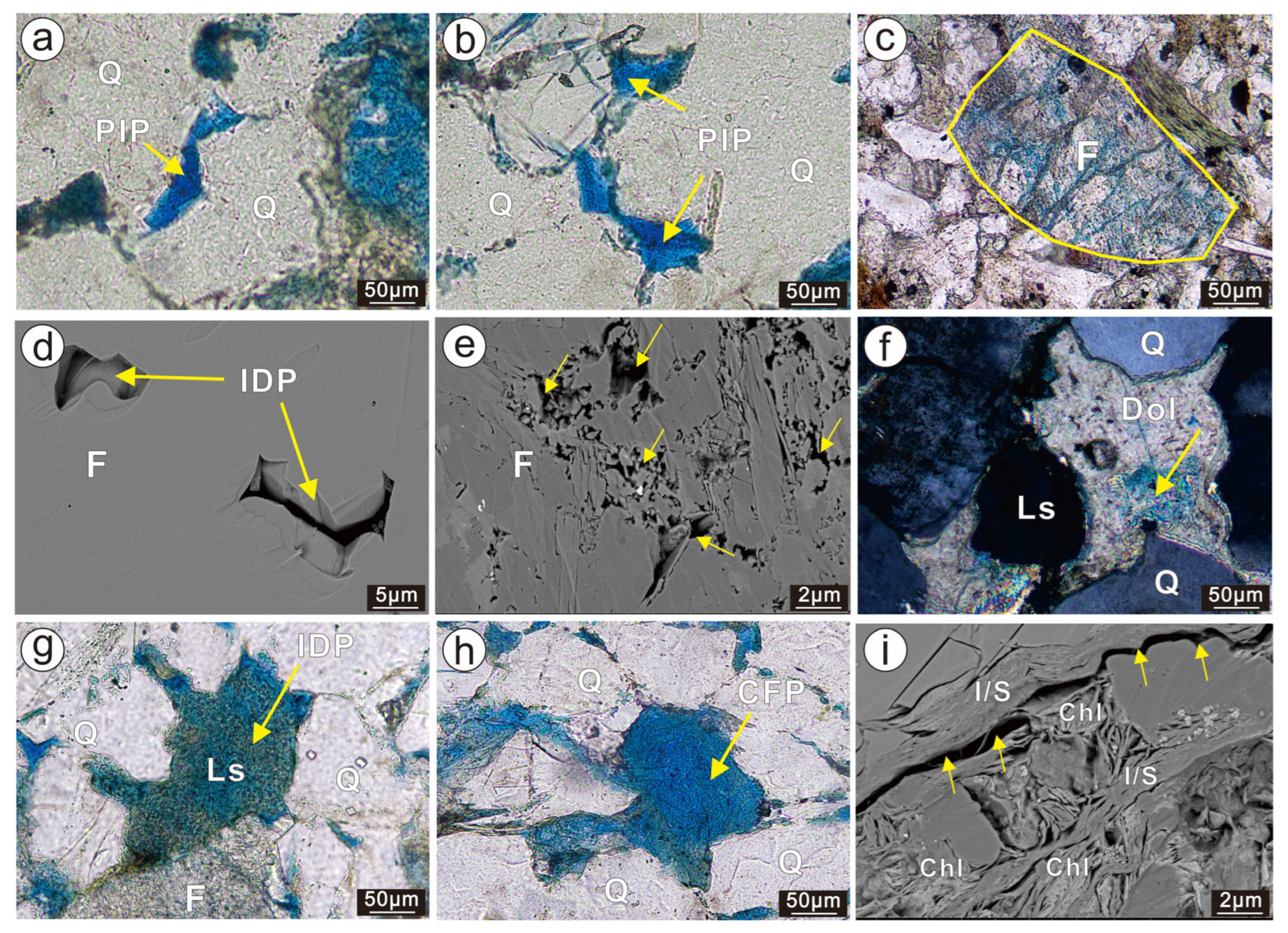

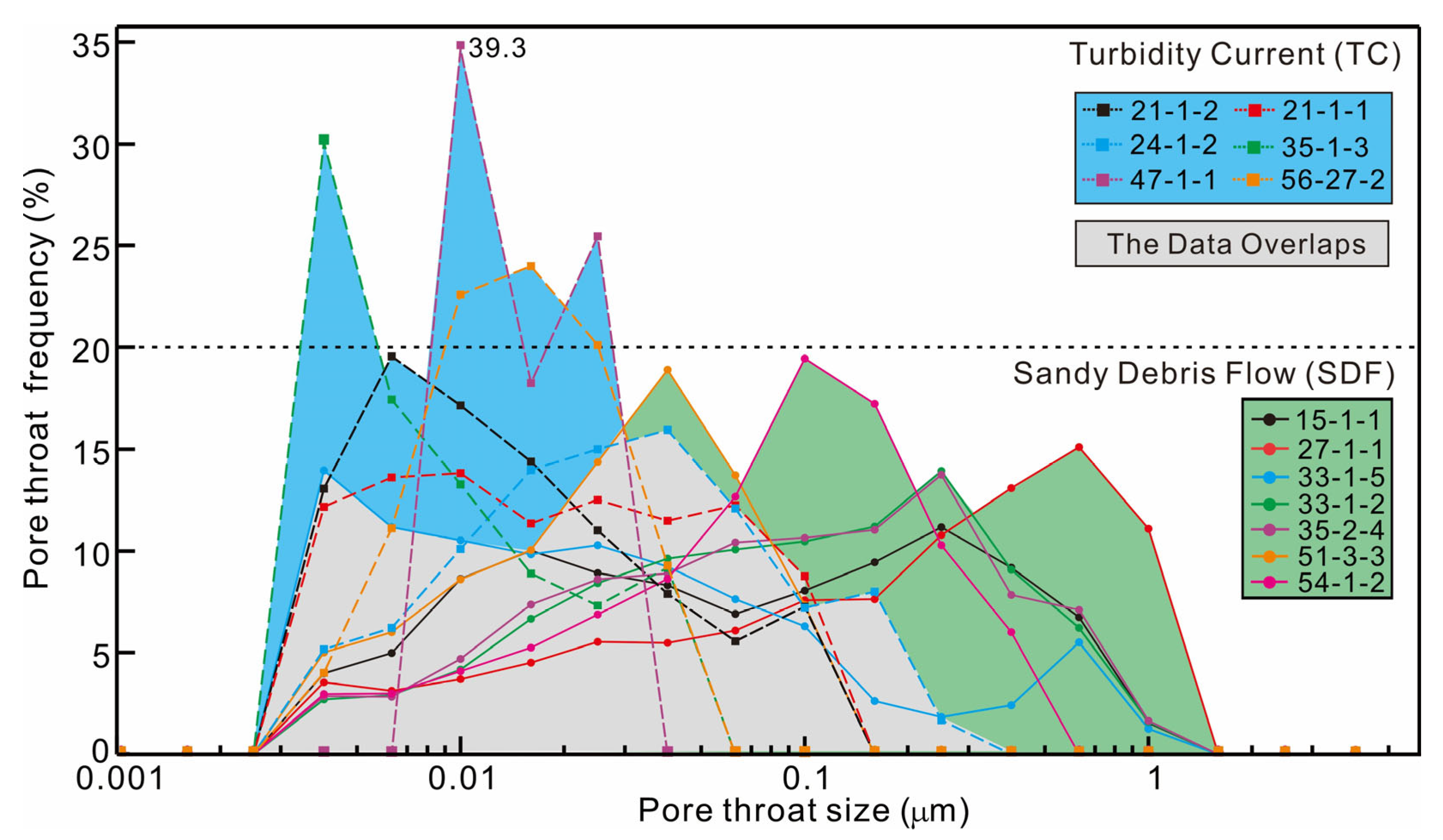
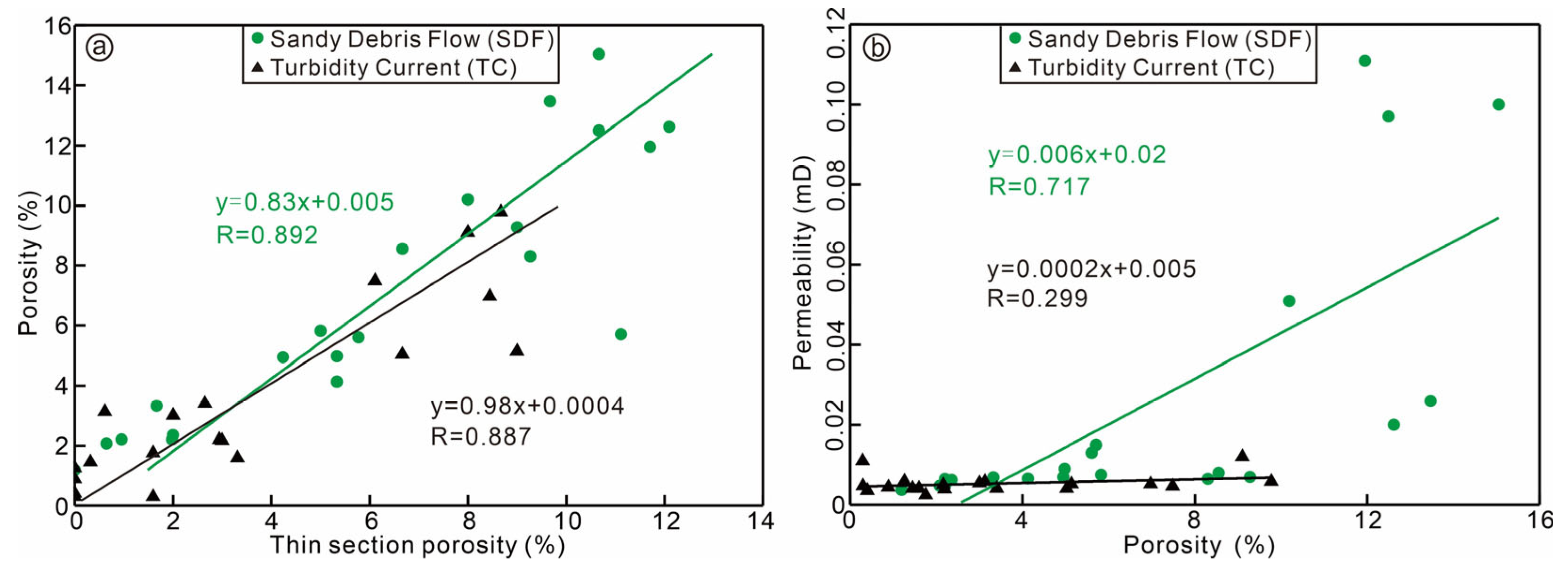




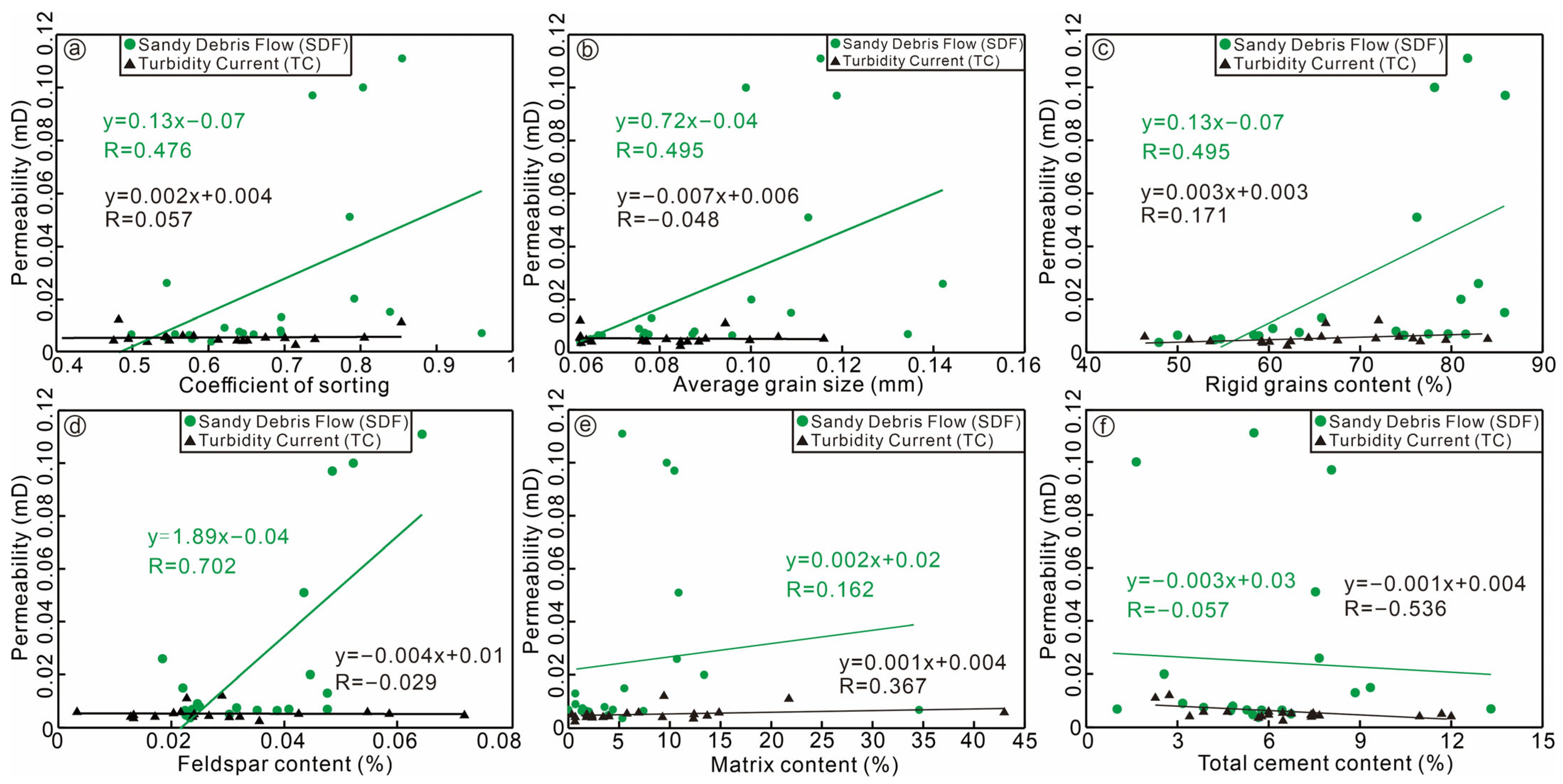

| Code | Lithofacies | Lithology | Sedimentary Features | Geometry | Typical Photos | Facies Association |
|---|---|---|---|---|---|---|
| Sm | Massive sandstone | Fine sandstone | Massive structure, sharp top and bottom contact with shale or gradual top contact with parallel bedding sandstone | Thin–very thick (0.05–2.5 m) parallel-sided beds | Figure 3a, Figure 4a and Figure 6b | SDF |
| Smm | Massive sandstone with mud clasts | Fine sandstone | Similar with lithofacies Sm except that containing floating mud clasts | Thin–very thick (0.05–2.5 m) parallel-sided beds | Figure 6b–d | SDF |
| St | Tongue-like sandstone | Fine sandstone | Similar with lithofacies Sm except for the terminal tongue-like bodies | Thin (0.05–0.1 m) parallel-sided beds | Figure 5a | SDF |
| Sn | Normal graded sandstone | Fine sandstone | Normal graded bedding with erosional base and flute casts on the bottom surface | Thin–very thick (0.05–2.0 m) parallel-sided beds | Figure 3c, Figure 7a and Figure 8b | TC |
| Ssm | Normal graded beds through siltstone to mudstone | Siltstone, mudstone | Siltstone has sharp bottom contact with shale and gradual top contact with mudstone | Very thin (0.01–0.03 m) parallel-sided beds | Figure 8d | TC |
| Sp | Parallel bedding sandstone | Fine sandstone | Parallel bedding, gradual bottom contact with lithofacies Sm or Smm and sharp top contact with mudstone | Medium–thick (0.2–0.4 m) parallel-sided beds | Figure 4a, Figure 6b and Figure 8b | TC |
| Sw | Wavy bedding sandstone | Fine sandstone | Wavy bedding, gradual bottom contact with lithofacies Sn and sharp top contact with mudstone | Very thin–thin (2.0–5.0 cm) parallel-sided beds | Figure 7c,d | TC |
| Sc | Internal contorted sandstone and mudstone | Fine sandstone, mudstone | Internal folding, with slip plane at the bottom of sandstone | Thick (0.3–0.6 m) non-parallel beds | Figure 9b | SP |
| Sps | Pillow-shaped sandstone | Fine sandstone | Load structures, developed at the bottom of sandstone | Medium (0.1–0.2 m), non-parallel beds | Figure 9c | SP |
| Sh | Black shale | Shale | Laminated lamina | Thin–thick (0.1–1.0 cm), parallel-sided lamina | Figure 3, Figure 4, Figure 5, Figure 6, Figure 7, Figure 8 and Figure 9 | DL |
| Mh | Horizontal bedding mudstone | Mudstone | Horizontal bedding | Very thin–thin (1.0–5.0 cm) parallel-sided beds | Figure 3c and Figure 8b | DL |
Disclaimer/Publisher’s Note: The statements, opinions and data contained in all publications are solely those of the individual author(s) and contributor(s) and not of MDPI and/or the editor(s). MDPI and/or the editor(s) disclaim responsibility for any injury to people or property resulting from any ideas, methods, instructions or products referred to in the content. |
© 2025 by the authors. Licensee MDPI, Basel, Switzerland. This article is an open access article distributed under the terms and conditions of the Creative Commons Attribution (CC BY) license (https://creativecommons.org/licenses/by/4.0/).
Share and Cite
He, Z.; Yang, M.; Wang, L.; Yin, L.; Zhang, P.; Zhou, K.; Turner, P.; Chen, Z.; Shao, L.; Lu, J. Reservoir Properties of Lacustrine Deep-Water Gravity Flow Deposits in the Late Triassic–Early Jurassic Anyao Formation, Paleo-Ordos Basin, China. Minerals 2025, 15, 888. https://doi.org/10.3390/min15090888
He Z, Yang M, Wang L, Yin L, Zhang P, Zhou K, Turner P, Chen Z, Shao L, Lu J. Reservoir Properties of Lacustrine Deep-Water Gravity Flow Deposits in the Late Triassic–Early Jurassic Anyao Formation, Paleo-Ordos Basin, China. Minerals. 2025; 15(9):888. https://doi.org/10.3390/min15090888
Chicago/Turabian StyleHe, Zhen, Minfang Yang, Lei Wang, Lusheng Yin, Peixin Zhang, Kai Zhou, Peter Turner, Zhangxing Chen, Longyi Shao, and Jing Lu. 2025. "Reservoir Properties of Lacustrine Deep-Water Gravity Flow Deposits in the Late Triassic–Early Jurassic Anyao Formation, Paleo-Ordos Basin, China" Minerals 15, no. 9: 888. https://doi.org/10.3390/min15090888
APA StyleHe, Z., Yang, M., Wang, L., Yin, L., Zhang, P., Zhou, K., Turner, P., Chen, Z., Shao, L., & Lu, J. (2025). Reservoir Properties of Lacustrine Deep-Water Gravity Flow Deposits in the Late Triassic–Early Jurassic Anyao Formation, Paleo-Ordos Basin, China. Minerals, 15(9), 888. https://doi.org/10.3390/min15090888








